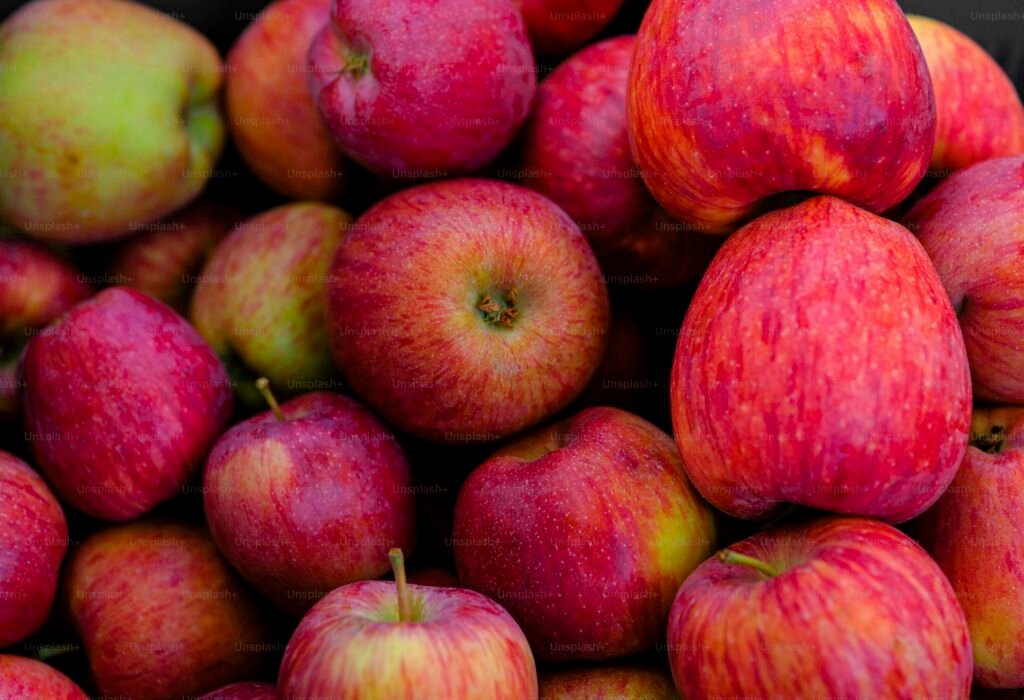The apple is one of the most widely cultivated and consumed fruits around the world. It is cherished not only for its sweet, tangy flavor and crunchy texture but also for its remarkable versatility in cooking, baking, and snacking. Apples come in various colors, shapes, and sizes, with different varieties offering distinct tastes—from sweet to tart. Throughout history, apples have been symbols of knowledge, health, and even temptation, appearing in myths, art, and folklore across cultures. This fruit is also celebrated for its significant role in the global food industry, with millions of tons grown each year across different continents.

Origin and History:
The apple’s origins trace back to Central Asia, particularly Kazakhstan, where wild ancestors of the modern apple still grow. The fruit spread across Asia, Europe, and eventually to the Americas through trade and colonization. Apples became symbolic in ancient cultures, from the Greek myths to the famous story of Isaac Newton’s discovery of gravity, which is said to have been inspired by an apple falling from a tree. Over time, apples became integral to farming, and today, they are grown in temperate regions all over the world.
Varieties:
There are thousands of apple varieties globally, with each offering unique characteristics. Some popular varieties include:
- Red Delicious: Known for its sweet flavor and deep red skin.
- Granny Smith: A tart, green apple often used in pies.
- Fuji: A cross between two varieties, known for its sweetness and crisp texture.
- Honeycrisp: A modern variety with a balanced sweet-tart flavor and extra-crisp bite.
Nutritional Profile:
Apples are a healthy fruit option, low in calories but high in important nutrients like vitamins, minerals, and antioxidants. A typical apple contains:
- Calories: Around 52 kcal per 100g
- Carbohydrates: 13.8g, including natural sugars
- Dietary Fiber: 2.4g, which aids in digestion
- Vitamin C: 4.6mg (important for immune function)
- Potassium: 107mg, beneficial for heart health
Health Benefits:
- Rich in Fiber: Apples are an excellent source of both soluble and insoluble fiber, helping to maintain a healthy digestive system and supporting heart health by lowering cholesterol levels.
- Antioxidant-Rich: Apples contain various antioxidants, such as flavonoids and polyphenols, which help reduce oxidative stress and inflammation in the body.
- Weight Management: Because they are high in fiber and water content, apples promote satiety and help control appetite, making them a great choice for those seeking to manage their weight.
- Blood Sugar Regulation: Apples have a low glycemic index and contain compounds that can help regulate blood sugar levels, making them beneficial for individuals with diabetes.
Culinary Uses:
Apples are highly versatile in cooking and baking. They can be eaten raw, used in salads, or paired with cheese. Apples are commonly featured in a wide range of dishes:
- Baking: Apple pie, apple crisp, and baked apples are classic desserts.
- Cooking: Apples can be roasted with meats (especially pork), added to salads, or used in sauces.
- Juices and Cider: Apples are pressed to make apple juice, apple cider, and alcoholic apple cider.
Storage:
To extend their shelf life, apples should be stored in a cool, dry place. Refrigerating them helps keep them fresh longer, especially for varieties that tend to ripen quickly. However, it is best to consume apples within a few weeks for the best flavor and texture.
Fun Facts:
- Apples are part of the Rosaceae family, which also includes other fruits like pears, peaches, and strawberries.
- There are over 7,500 different varieties of apples worldwide.
- Apple seeds contain a small amount of amygdalin, which can release cyanide if consumed in large quantities, though you’d have to eat an enormous amount of seeds for this to be harmful.
- The apple’s air-filled interior allows it to float, which is why it’s commonly used in the Halloween game of “apple bobbing.”
